Utilising Neutrosophic Logic in the Design of a Smart Air-Conditioning System
Abstract
:1. Introduction
2. Related Work
3. Preliminaries
4. Proposed System Design and Simulation
4.1. Working Principle of Sensor
4.2. Variables That Describe the Proposed System
4.2.1. Input Variables
Outside Temperature (OTE)
Humidity(H)
Occupants (O)
Activity Type (A)
Period of the Day (TOD)
4.2.2. Output Variables
Temperature (T)
Compressor Speed (CS)
Fan Speed (FS)
4.3. Neutrosophication
5. Results and Discussions
6. Conclusions
Author Contributions
Funding
Informed Consent Statement
Conflicts of Interest
References
- Parnin, S.; Rahman, M. Human Location Detection System Using Micro-Electromechanical Sensor for Intelligent Fan. IOP Conf. Ser. Mater. Sci. Eng. 2017, 184, 012042. [Google Scholar] [CrossRef]
- Sobhy, S.M.; Khedr, W.M. Developing of fuzzy logic controller for air condition system. Int. J. Comput. Appl. 2015, 126, 1–8. [Google Scholar]
- Islam, A.; Hossain, S. The Development of Fuzzy Logic Controller (FLC) in Air Conditioning System Using Several Types of Fuzzy Numbers. Intern. J. Fuzzy Math. Arch. 2021, 19, 1–24. [Google Scholar] [CrossRef]
- Soleimanzadeh, A. Designing Fuzzy Controller for Air Conditioning Systems in order to Save Energy Consumption and Provide Optimal Conditions in Closed Environments. J. Artif. Intell. Electr. Eng. 2014, 3, 11–18. [Google Scholar]
- Das, T.K.; Das, Y. Design of a Room Temperature and Humidity Controller Using Fuzzy Logic. Am. J. Eng. Res. 2013, 2, 86–97. [Google Scholar]
- Patil, C.B.; Mudholkar, R.R. Design and Implementation of Genetic Fuzzy Controller for Split Air-Conditioner Control Based on Fanger’s PMV Index. Int. J. Air-Conditioning Refrig. 2019, 27, 1950036-1-12. [Google Scholar] [CrossRef]
- Shah, Z.A.; Sindi, H.F.; Ul-Haq, A.; Ali, M.A. Fuzzy Logic-Based Direct Load Control Scheme for Air Conditioning Load to Reduce Energy Consumption. IEEE Access 2020, 8, 117413–117427. [Google Scholar] [CrossRef]
- Mohanraj, M.R.; Balamurugan, M.; Suresh, V.P.; Gubo, R. Design of Air-Conditioning Controller by using Mamdani and Sugeno Fuzzy Inference Systems. South Asian J. Eng. Technol. 2016, 2, 7–16. [Google Scholar]
- Sierra, L.; Araya, F.; Yepes, V. Consideration of Uncertainty and Multiple Disciplines in the Determination of Sustainable Criteria for Rural Roads Using Neutrosophic Logic. Sustainability 2021, 13, 9854. [Google Scholar] [CrossRef]
- Lundgren-Kownacki, K.; Hornyanszky, E.D.; Chu, T.A.; Olsson, J.A.; Becker, P. Challenges of using air conditioning in an increasingly hot climate. Int. J. Biometeorol. 2017, 62, 401–412. [Google Scholar] [CrossRef]
- Zadeh, L.A. Fuzzy Sets. Inf. Control 1965, 8, 338–353. [Google Scholar] [CrossRef]
- Hang, L.; Kim, D.-H. Enhanced Model-Based Predictive Control System Based on Fuzzy Logic for Maintaining Thermal Comfort in IoT Smart Space. Appl. Sci. 2018, 8, 1031. [Google Scholar] [CrossRef]
- Dash, S.K.; Mohanty, G.; Mohanty, A. Intelligent Air Conditioning System using Fuzzy Logic. Int. J. Sci. Eng. Res. 2012, 3, 1–6. [Google Scholar]
- Uplenchwar, K.B.; Ingle, V.R. Design of Fuzzy Inference System for Autonomous Air Conditioner. In Proceedings of the IJCA Proceedings on International Conference on Advancements in Engineering and Technology (ICAET 2015), Wardha, India, 11 April 2015. [Google Scholar]
- Ahamed, N.U.; Taha, Z.; Rabbi, M.; Rahaman, S.A.M.M.; Sundaraj, K. Fuzzy Logic Controller Design for Intelligent Air-Conditioning System. In Proceedings of the 2nd International Conference on Control Science and Systems Engineering©2016 IEEE, Singapore, 27–29 July 2016. [Google Scholar]
- Salamone, F.; Belussi, L.; Currò, C.; Danza, L.; Ghellere, M.; Guazzi, G.; Lenzi, B.; Megale, V.; Meroni, I. Integrated Method for Personal Thermal Comfort Assessment and Optimization through Users’ Feedback, IoT and Machine Learning: A Case Study. Sensors 2018, 18, 1602. [Google Scholar] [CrossRef]
- Smarandache, F. A unifying field in logics: Neutrosophic logic. In Philosophy; American Research Press: Rehoboth, Germany, 1999; pp. 1–141. [Google Scholar]
- Alata, M.; Al-Nimr, M.; Al-Jarrah, R. Fuzzy Control of the Air Conditioning System at Different Operating Pressures. Int. J. Mech. Mechatron. Eng. 2012, 6, 2480–2486. [Google Scholar]
- Attia, A.-H.; Rezeka, S.F.; Saleh, A.M. Fuzzy logic control of air-conditioning system in residential buildings. Alex. Eng. J. 2015, 54, 395–403. [Google Scholar] [CrossRef] [Green Version]
- Saxena, A.; Prasad, M.; Gupta, A.; Bharill, N.; Patel, O.P.; Tiwari, A.; Er, M.J.; Ding, W.; Lin, C.-T. A review of clustering techniques and developments. Neurocomputing 2017, 267, 664–681. [Google Scholar] [CrossRef]
- Bishop, C.M. Pattern Recognition and Machine Learning. Information Science and Statistics; Springer: New York, NY, USA, 2006. [Google Scholar]
- Chaudhari, P.; Oberman, A.; Osher, S.; Soatto, S.; Carlier, G. Deep relaxation: Partial differential equations for optimizing deep neural networks. Res. Math. Sci. 2018, 5, 1–30. [Google Scholar] [CrossRef]
- Purwanto, F.H.; Utami, E.; Pramono, E. Design of Server Room Temperature and Humidity Control System using Fuzzy Logic Based on Microcontroller. In Proceedings of the 2018 International Conference on Information and Communications Technology (ICOIACT), Yogyakarta, Indonesia, 6–7 March 2018. [Google Scholar]
- Parameshwaran, R.; Karunakaran, R.; Kumar, C.V.R.; Iniyan, S. Energy conservative building air conditioning system controlled and optimized using fuzzy-genetic algorithm. Energy Build. 2010, 42, 745–762. [Google Scholar] [CrossRef]
- Habib, S.; Ashraf, A.; Butt, M.A.; Ahmad, M. Medical diagnosis based on single-valued neutrosophic information. Neutrosophic Sets Syst. 2021, 42, 302–323. [Google Scholar]
- Hasim, N.; Mohd Shahrieel, M.A. Intelligent Room Temperature Controller System Using MATLAB Fuzzy Logic Toolbox. Int. J. Sci. Res. 2012, 3, 1748–1753. [Google Scholar]
- Kumari, R.; Kumar, S.; Sharma, V.K. Air Conditioning System with Fuzzy Logic and Neuro-Fuzzy Algorithm. Adv. Intell. Syst. Comput. 2014, 236, 233–242. [Google Scholar] [CrossRef]
- Cheng, C.-C.; Lee, D. Smart Sensors Enable Smart Air Conditioning Control. Sensors 2014, 14, 11179–11203. [Google Scholar] [CrossRef] [PubMed]
- Yan, H.; Pan, Y.; Li, Z.; Deng, S.S. Further development of a thermal comfort based fuzzy logic controller for a direct expansion air conditioning system. Appl. Energy 2018, 219, 312–324. [Google Scholar] [CrossRef]
- Waheed, S.R.; Adnan, M.M.; Suaib, N.M.; Rahim, M.S.M. Fuzzy Logic Controller for Classroom Air Conditioner. J. Phys. Conf. Ser. 2020, 1484, 012018. [Google Scholar] [CrossRef]
- Kochev, M.; Ivanova, M. Modernization of a Cooling Water Control System for the Production of Plastic Pipes Using Fuzzy Logic. AIP Conf. Proc. 2021, 2333, 070012. [Google Scholar] [CrossRef]
- Sinha, S.K.; Kumar, C. Healthcare Information Retrieval Based on Neutrosophic Logic. Adv. Intell. Syst. Comput. 2019, 1085, 225–234. [Google Scholar] [CrossRef]
- Fu, Z.; Liu, C.; Ruan, S.; Chen, K. Design of Neutrosophic Self-Tuning PID Controller for AC Permanent Magnet Synchronous Motor Based on Neutrosophic Theory. Math. Probl. Eng. 2021, 2021, 1–14. [Google Scholar] [CrossRef]
- Belman-Flores, J.M.; Rodríguez-Valderrama, D.A.; Ledesma, S.; García-Pabón, J.J.; Hernández, D.; Pardo-Cely, D.M. A Review on Applications of Fuzzy Logic Control for Refrigeration Systems. Appl. Sci. 2022, 12, 1302. [Google Scholar] [CrossRef]
- Aggarwal, H.; Arora, H.D.; Kumar, V. A Decision-making Problem as an Applications of Intuitionistic Fuzzy Set. Int. J. Eng. Adv. Technol. 2019, 9, 5259–5261. [Google Scholar] [CrossRef]
- Das, S.; Roy, B.K.; Kar, M.B.; Kar, S.; Pamučar, D. Neutrosophic fuzzy set and its application in decision making. J. Ambient Intell. Humaniz. Comput. 2020, 11, 5017–5029. [Google Scholar] [CrossRef]
- Available online: https://www.linkedin.com/pulse/automatic-ac-control-motion-sensor-enic-engineering (accessed on 5 July 2022).
- Available online: https://niwa.co.nz/education-and-training/schools/resources/climate/plots (accessed on 20 July 2022).
- Rizvi, S.; Mitchell, J.; Razaque, A.; Rizvi, M.R.; Williams, I. A fuzzy inference system (FIS) to evaluate the security readiness of cloud service providers. J. Cloud Comput. Adv. Syst. Appl. 2020, 9, 1–17. [Google Scholar] [CrossRef]
- Available online: https://www.moneycontrol.com/news/business/economy/explained-why-you-should-keep-the-ac-at-24c-4711541.html (accessed on 3 July 2022).
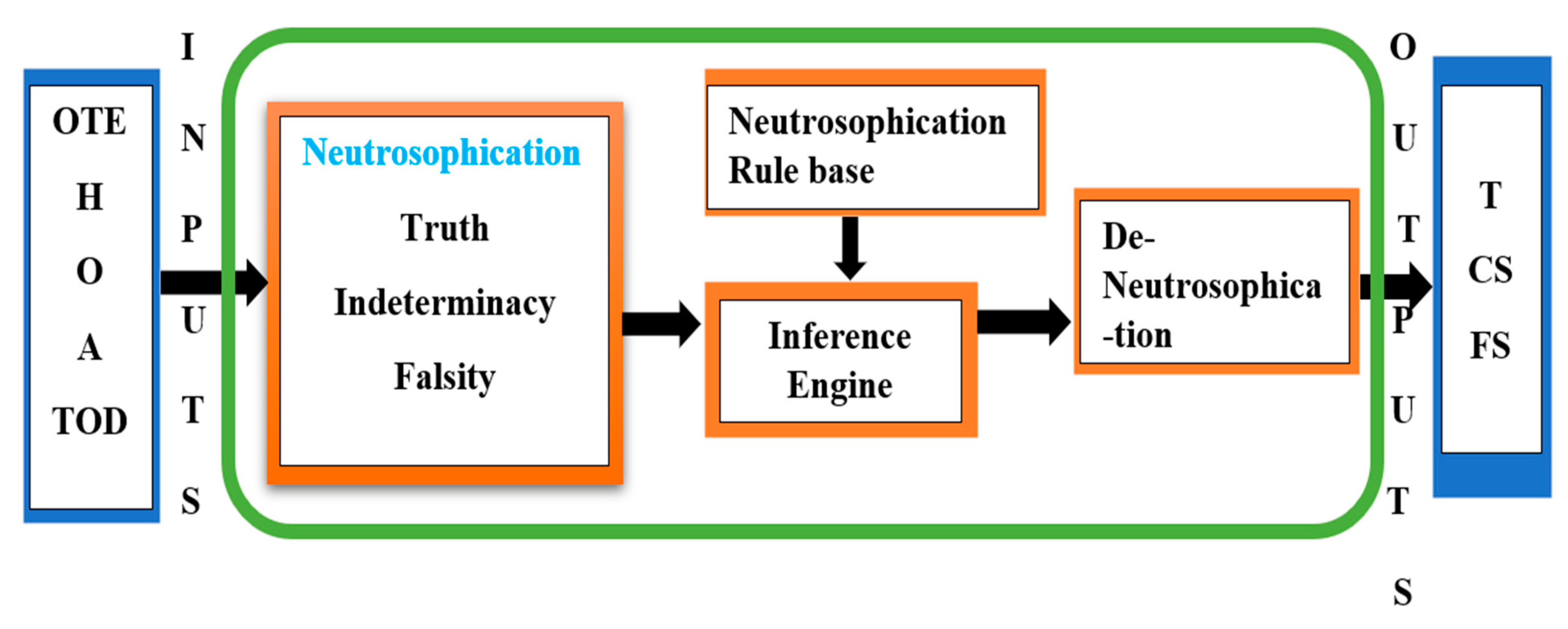
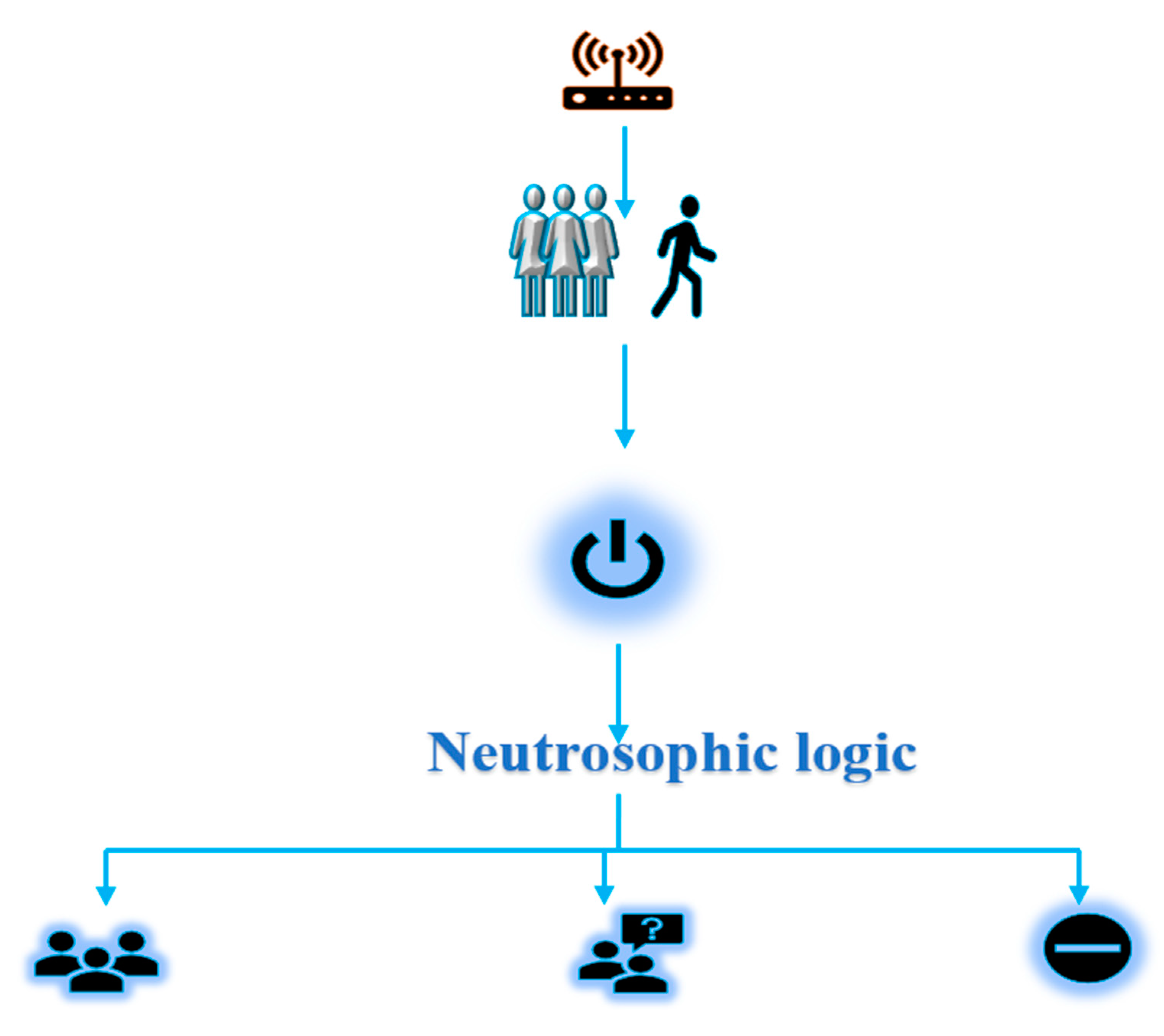
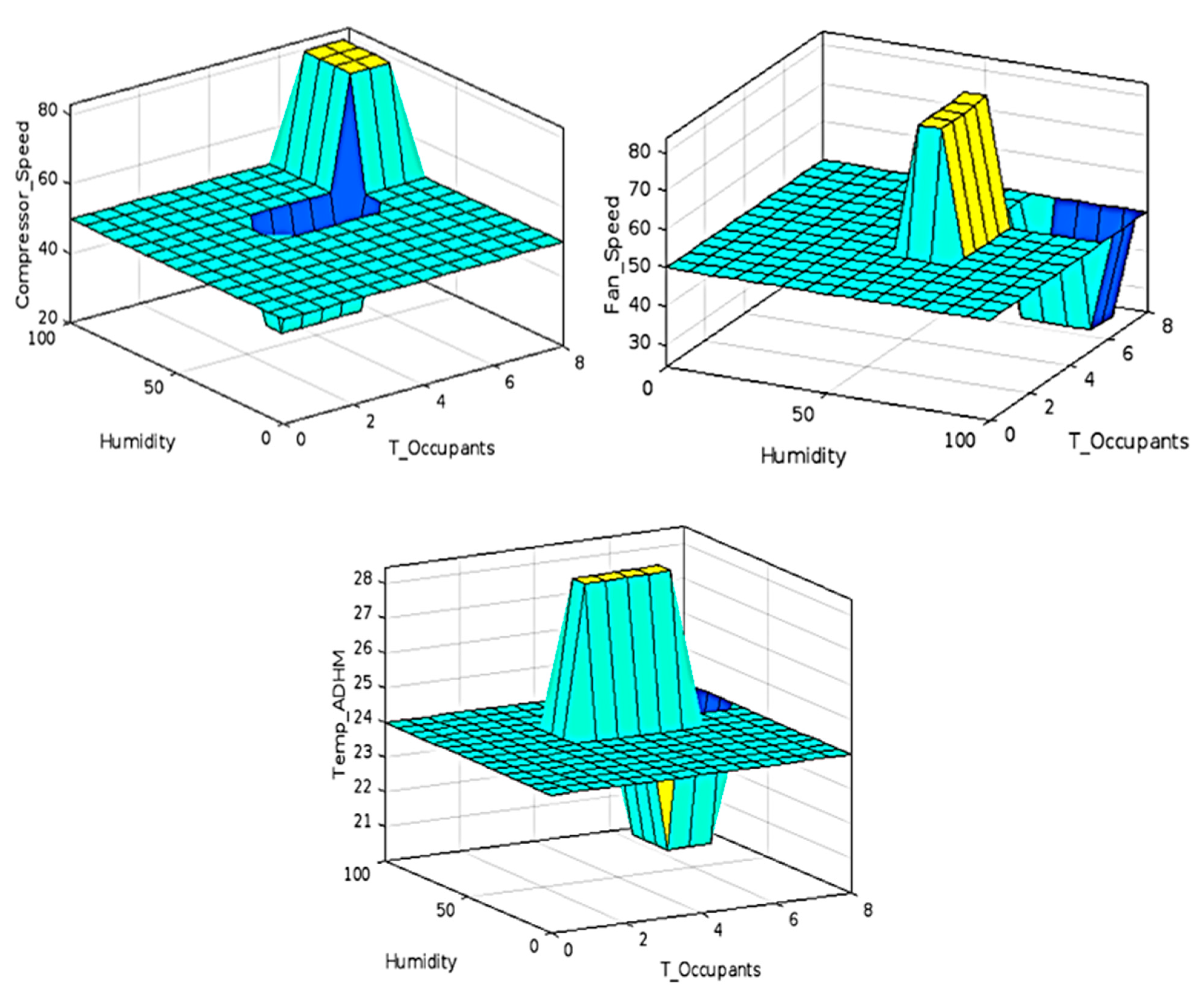
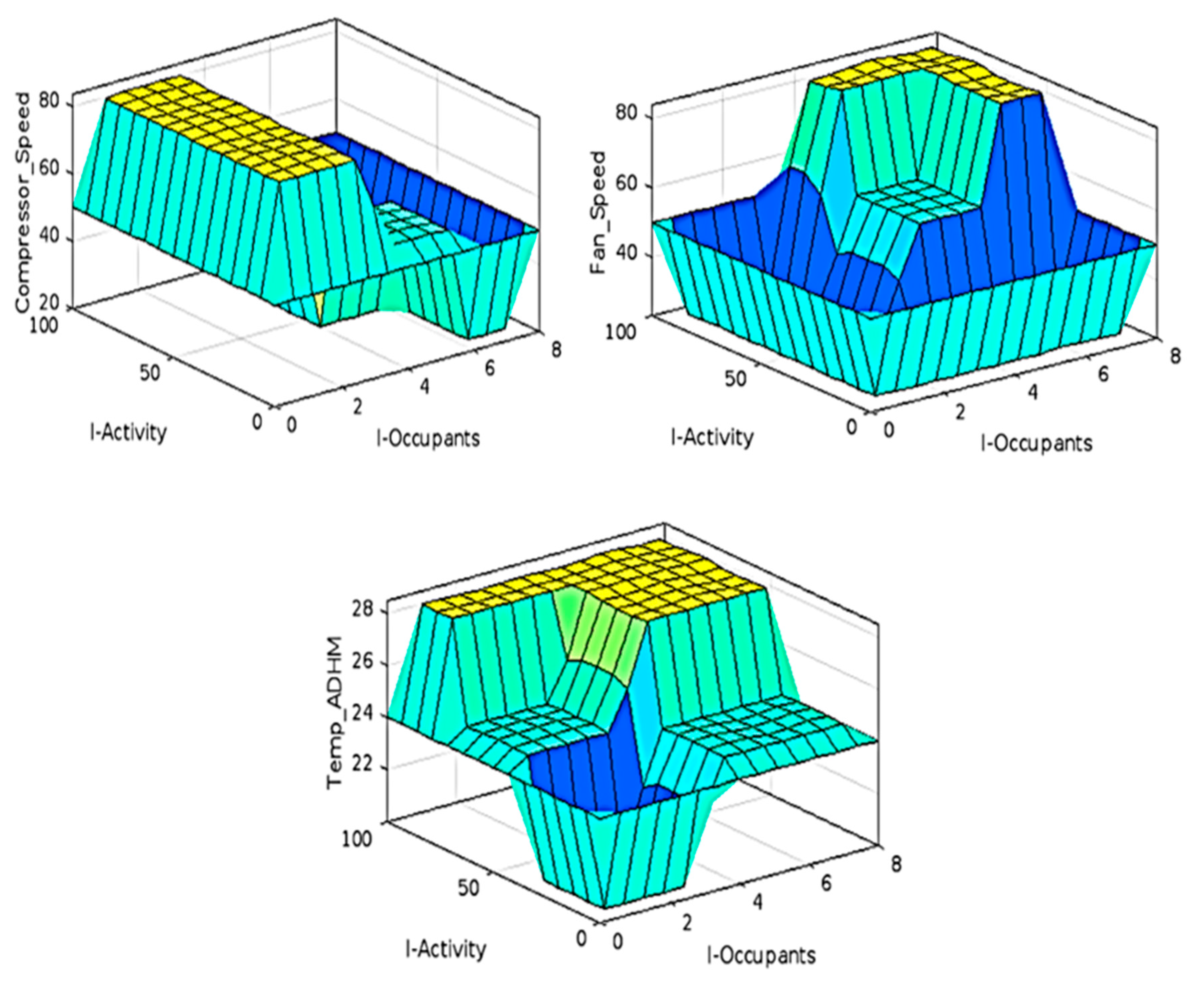
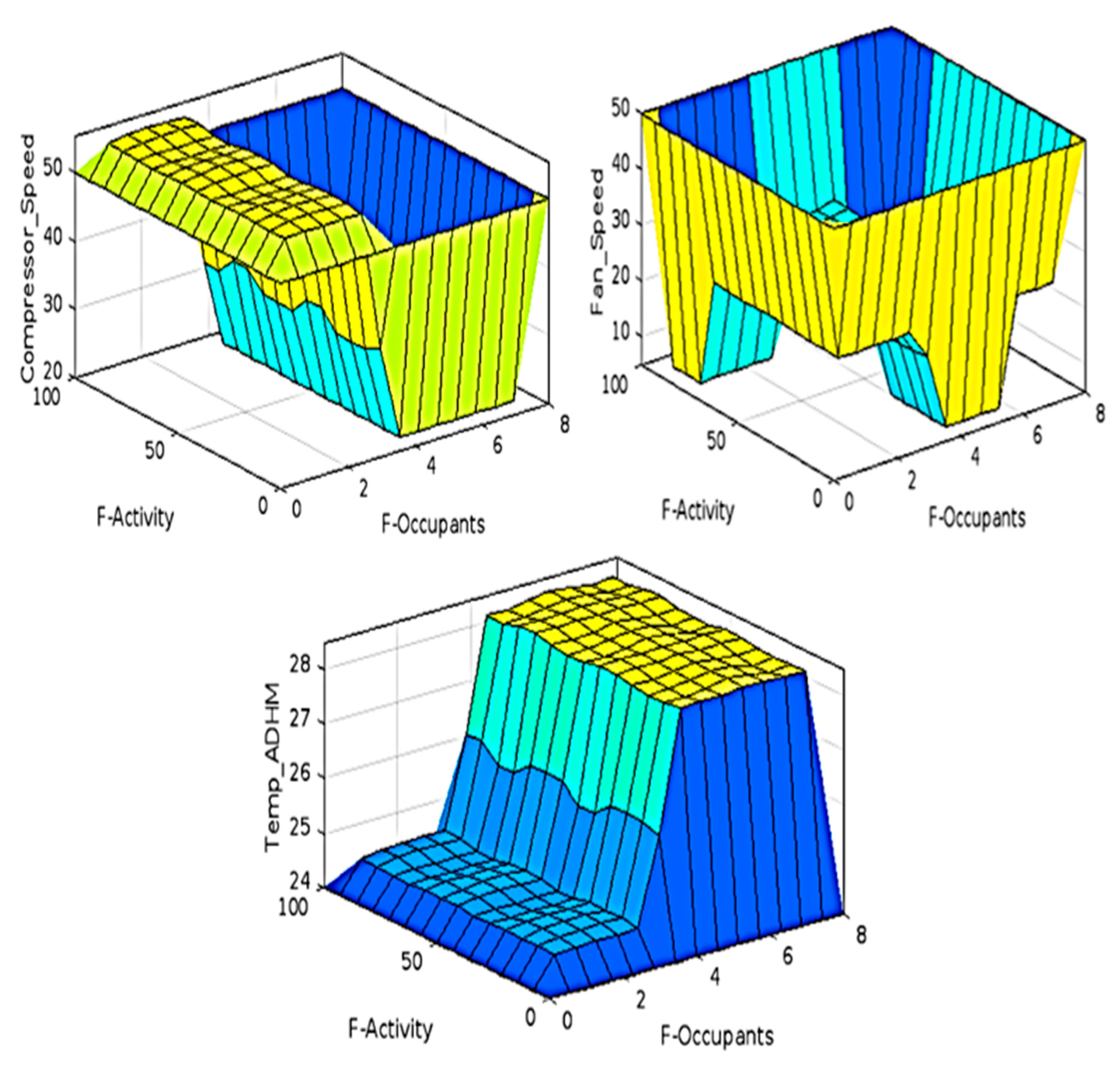
| Variables in the Proposed System | Membership Functions | ||||
|---|---|---|---|---|---|
| TFNs (Triangular Fuzzy Numbers) | |||||
| I-1 (I-Input) | Outside temperature Range: [0–100%] | Low [0–30] | Moderate [30–60] | High [50–80] | Very high [75–100] |
| I-2 | Humidity Range: [0–100%] | Dry [0–50] | Normal [50–70] | Sticky [70–100] | - |
| I-3 | Occupants Range: [0–8] | Low [0–4] | Medium [3–6] | High [6–8] | - |
| I-4 | Activity Range: [0–100%] | Less [0–40] | Medium [40–75] | More [75–100] | - |
| I-5 | TOD Range: [0–24 h] | Morning [0–11:30] | Afternoon [11–17] | Night [17–24] | - |
| OT-1 (OT-Output) | Temperature Range: [18–30 ℃] | Low [18–22] | Medium [22–27] | High [27–30] | - |
| OT-2 | Compressor Speed Range: [0–100%] | Low [0–40] | Medium [38–70] | High [65–100] | - |
| OT-3 | Fan Speed Range: [0–100%] | Off [0–10] | Minimum [10–40] | Average [40–70] | Maximum [68–100] |
| Inputs | Outputs | ||||||
|---|---|---|---|---|---|---|---|
| OTE | H | T-O | T-A | TOD | Temp. | CS | FS |
| Low | Dry | Less | More | Morning | High | Slow | Medium |
| Low | Normal | Medium | More | Morning | Low | Slow | High |
| Very high | Sticky | More | More | Morning | Low | Fast | Low |
| Very high | Sticky | More | Medium | Afternoon | Low | Fast | Low |
| Inputs | Outputs | |||
|---|---|---|---|---|
| ID-O | ID-A | Temp. | CS | FS |
| Low | Low | Low | Fast | Low |
| Medium | Low | Medium | Medium | Low |
| High | High | High | Slow | High |
| Inputs | Outputs | |||
|---|---|---|---|---|
| F-O | F-A | Temp. | CS | FS |
| High | Low | High | Slow | Slow |
| Low | Low | Medium | Medium | Slow |
| Medium | High | High | Slow | Slow |
| Neutrosophic Logic | Compressor Speed (%) | Fan Speed (%) | Temperature (℃) |
|---|---|---|---|
| Truth of occupants | 50 | 50 | 24 |
| Indeterminacy of occupants | 20 | 55 | 28.4 |
| Falsity of occupants | 20 | 23.6 | 28.4 |
Publisher’s Note: MDPI stays neutral with regard to jurisdictional claims in published maps and institutional affiliations. |
© 2022 by the authors. Licensee MDPI, Basel, Switzerland. This article is an open access article distributed under the terms and conditions of the Creative Commons Attribution (CC BY) license (https://creativecommons.org/licenses/by/4.0/).
Share and Cite
Karunakaran, H.; Bhumireddy, V. Utilising Neutrosophic Logic in the Design of a Smart Air-Conditioning System. Appl. Sci. 2022, 12, 9776. https://doi.org/10.3390/app12199776
Karunakaran H, Bhumireddy V. Utilising Neutrosophic Logic in the Design of a Smart Air-Conditioning System. Applied Sciences. 2022; 12(19):9776. https://doi.org/10.3390/app12199776
Chicago/Turabian StyleKarunakaran, Hemalatha, and Venkateswarlu Bhumireddy. 2022. "Utilising Neutrosophic Logic in the Design of a Smart Air-Conditioning System" Applied Sciences 12, no. 19: 9776. https://doi.org/10.3390/app12199776




